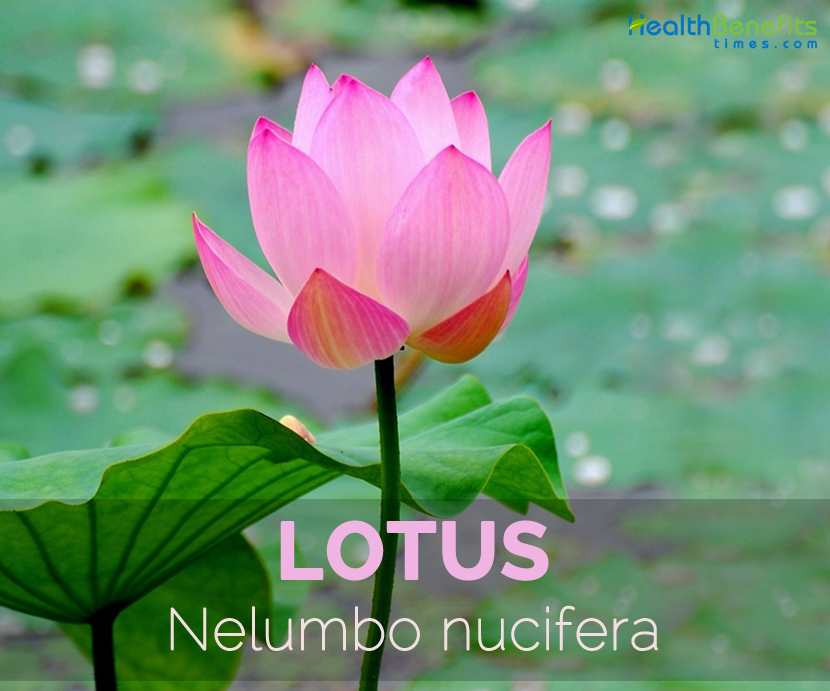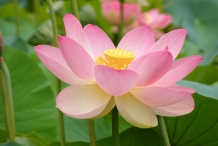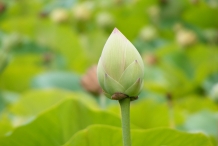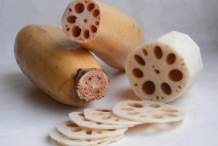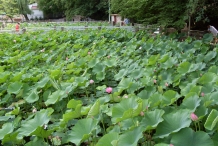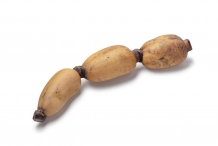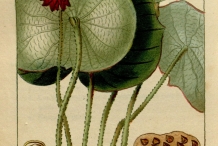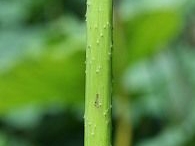| Lotus Quick Facts |
| Name: |
Lotus |
| Scientific Name: |
Nelumbo nucifera |
| Origin |
Tropical Asia and Queensland (Australia) which is widely cultivated in water gardens. |
| Colors |
Brown |
| Shapes |
Nut, oblong-ovoid, glabrous, 1.0–2.0 × 7–1.5 cm |
| Calories |
40 Kcal./cup |
| Major nutrients |
Vitamin C (18.22%)
Copper (14.44%)
Vitamin B6 (10.08%)
Carbohydrate (7.39%)
Iron (6.75%)
|
| Health benefits |
Circulates blood, Influence mood, Flow of blood, Reduce constipation, Antioxidant activity |
| More facts about Lotus |
Nelumbo nucifera, under the more common names of the Hindu Lotus, Egyptian Bean, Lotus, Indian Lotus, Lotus Bean, Sacred Lotus, Oriental Lotus, Water Lotus, is a perennial flowering aquatic herb which are found on the fresh water. It has floating leaves and rooted plant, grows about 150 cm high. The plant rises from the rhizomes which are planted in the soil. It is many petaled flowers which grow in the range of white to rosy. These flowers rise above several centimeters on thick stems above the water.
It is the member of Nelumbonaceae family native to Tropical Asia and Queensland (Australia) which is widely cultivated in water gardens. Lotus lives over a thousand years. It grows in a warm-temperate to tropical climates. Some varieties of Lotus are: Asiatic, Chawan Basu, Chinese Double Rose, Momo Botan, Mrs. Perry D. Slocum, Perry’s Giant Sunburst, Rosea Plena and Sacred Pink.
History
In the 18th century, it has been introduced in Europe as a water lily but today it is found all over the world in modern botanical gardens. Lotus plants are typically cultivated in Japan, Australia, India, China and Iran.
The lotus flower is also regarded as a symbol of purity and beauty in both Buddhist and Hindu religions. It is illustrated in religious pictures and texts. During 1999, it was served in China as an industrial crop. Lotus was cultivated for more than 1000 years in Japan which was introduced from China.
Plant
Lotus is perennial, rhizomatous and aquatic herb which usually grows to the height of 150 cm and has a horizontal spread of 3 meters. The roots are long, slightly round from white to reddish and brown. The leaves are large which float on the surface of water. The leaves are water repellant, orbicular, concave-cupshaped with 60 cm as a diameter. The stems are thick which bears flowers several centimeters above the water. The flowers are hermaphrodite, oblong elliptic to obovate, about 10-25 cm diameter and are sweet scented. Petals are white to rosy and numerous. Flowers bloom in the morning and closes in the evening. The fruits are like nuts, oblong-ovoid, brown, glabrous with the size of 1.0–2.0 × 7–1.5 cm. The fruit possess the black, hard and ovoid seeds.
Seeds
Lotus seeds are sweet edible seeds of lotus flower ans is a good source of nutrients, vitamins and minerals. It is commonly known as makhana in India and is small, round and white or off-white in appearance. They are low in saturated fats, sodium and cholesterol; high in magnesium potassium, thiamine and phosphorus and are used in desserts, rice porridge, soups and stir fry dishes.
Nutritional Value
The serving of one cup measuring 60 gm contributes 0.95 gram of protein, 0.04 gram of total fat and 1.9 gram of dietary fiber. It serves 16.4 mg of Vitamin C, 0.13 mg of Copper, 0.131 mg of Vitamin B6, 0.54 mg of Iron, 47 mg of Phosphorus and others. Lotus root is composed of 48.85 gram of water and 0.3 gram of total sugar.
Health Benefits of Lotus
All parts of the Lotus plant are edible and provides numerous health benefits. The lotus root is used to treat various health ailments and to add seasoning to the food. It is composed with several vitamins, minerals and nutrients. Due to the richness in Vitamin C, it benefits the body in various ways. The ample amount of potassium helps to reduce fatigue, heart problems, irritability and high blood pressure. Minerals such as iron assist in producing red blood cells.
- Circulates blood
The Lotus root promotes the blood circulation which helps to raise oxygenation of organs and also increase the functions and energy level. The presence of copper and iron in meaningful amount assist in the production of red blood cells, lowers the risk of anemia, increases the blood flow as well as vitality. (1)
- Influence mood
The presence of pyridoxine interacts with the neural receptors in brain which impacts the mental state and mood. It eradicates headaches, irritability and stress level. The flowers of Lotus are associated with tranquility and peace. (2)
- Flow of blood
Lotus root contains potassium in significant amount which helps to maintain the balance the fluids and prevent the sodium effects in the bloodstream. Potassium acts as a vasodilator which helps to relax the blood vessels, lowers the rigidity and contraction, increase blood flow and lowers the stress on cardiovascular system. Potassium is vital for the neural activity and transport the blood and fluid to the brain. (3)
- Reduce constipation
Lotus root is loaded with dietary fiber which adds bulk to the stool and ease bowel movements. This can lower the constipation, increase nutrient absorption through the digestive and gastric juice secretion, stimulates the peristaltic motion in the intestinal muscles and ease the bowel movements. (4)
- Antioxidant activity
Vitamin C is an antioxidant which is found in high amount. It is vital for the formation of collagen; maintain strength and integrity in the organs, vessels and skin. It enhances the immune functions. In addition, Vitamin C eradicates the free radicals from the body that leads to the health conditions like heart disease and cancer. (5)
- Prevent heart ailments
Potassium is a vasodilator and dietary fiber has the cholesterol scrubbing ability. The lotus root contains the pyridoxine which helps to control the homocysteine level in the blood that are associated to heart attacks. (6)
- Regulates weight
Lotus root helps to manage the weight due to low calorie content and high amount of fiber and nutrients. It provides all the nutrients and make full for long periods of time which lowers the chances of overeating and also manage obesity. (7)
- High in Vitamin A
Lotus roots are an excellent source of Vitamin A which enhances the skin, eyes and hair health. The antioxidant activities prevent ocular conditions and macular degeneration, speeds up the healing process, reduces inflammation and skin ailments. (8)
https://www.youtube.com/watch?v=WAtL85Pl28I
Traditional uses
- Lotus leaf has been used for summer heat syndrome as home remedy in Japan and China, and it has recently been used to treat obesity in China.
- Embryo of lotus seeds is used in traditional Chinese drug called ‘Lian Zi Xin’, which primarily helps to overcome nervous disorders, insomnia, high favors and cardiovascular diseases.
- Lotus leaf is known to be effective for ‘overcoming body heat’ and stopping bleeding and is commonly used as a traditional curing plant for the treatment of hematemesis, epistaxis, hemoptysis, hematuria and metrorrhagia in traditional Chinese medicine.
- The herb of lotus leaves is the traditional Chinese medicine He Ye, which is commonly used to treat sunstroke, assuage thirst and cure both diarrhea and fever in China.
- In traditional Korean medicine, lotus roots have been used as an anti-diabetic and an anti-proliferative remedy.
- In folk medicines, seeds are used in the treatment of tissue inflammation, cancer, skin diseases and leprosy; used as poison antidote, antiemetic and cooling agent; and generally prescribed to children as diuretic and refrigerant.
- The fruits and seeds of lotus are astringent and used to treat hyperpiesia, dermatopathy, halitosis, menorrhagia, leprosy and fever.
- Seed powder mixed with honey is useful in treating cough, while roots with ghee (melted fresh butter), milk and gold promote strength, virility and intellect.
- Its rhizomes are used for treating pharyngopathy, pectoralgia, spermatorrhoea, leucoderma, small pox, diarrhea, dysentery and cough.
- The stem is used in indigenous Ayurvedic medicines as a diuretic and anthelmintic and to treat strangury, vomiting, leprosy, skin diseases and nervous exhaustion.
- Young leaves with sugar are useful to treat rectal prolapse, and the leaves boiled with Mimosa pudica in goat’s milk can be used to treat diarrhea.
- It has been used for the treatment of several disorders including skin disease, cough, inflammation, fever and many other disorders.
- The leaves are used as an effective drug for hematemesis, epistaxis, haemoptysis, haematuria, metrorrhagia, fever and inflammatory skin conditions.
- Its seed has been used as an anti-obesity agent in traditional Chinese herbal medicine.
- Hyper lipidaemia in rodents can be treated with lotus leaves.
- Leaves also possess diuretic and astringent properties and help to treat fever, sweating and strangury and as styptic
- The Chinese administer the rhizomes for diarrhea and dysentery; the Cambodians make a tea for menorrhagia.
- The Chinese used the embryo to reduce high fever and in the treatment of cholera, hemoptysis and spermatorrhoea.
- In Malayan medicine, it is highly esteemed as a tonic and taken as tea for fever.
- The Malays used pounded petals for syphilis.
- They are astringent and taken for diarrhea and vomiting in Java.
- The Chinese used them in facial cosmetic.
- In India, they are used for fever and in the Philippines for dysentery.
- The stamens are astringent and diuretic and used by the Chinese.
- They are also used in cosmetics.
- In India, they are employed as an astringent and cooling medicine.
- In Indonesia and India, the juice from the petioles and peduncles is used for treating diarrhea.
- In Vietnam, the seeds are used to treat dysentery, spermatorrhoea, leucorrhoea, palpitation, insomnia, general debility and anorexia.
- The plumules are useful in the therapy of permanent mild fever, insomnia, thirst and haemoptysis.
- The leaves are beneficial in treating bloody stools, hematuria, gingival and subcutaneous hemorrhage.
- The stamens are effective for metrorrhagia, haemoptysis, spermotorrhoea and insomnia.
- The achene in decoction is used for treating dysentery and aphonia.
- The receptacle in decoction is useful as hemostatic in treating bloody stools, urination, leucorrhoea and hypertension.
- Rhizome decoction is used as hemostatic in treating bloody stools, hematuria, haematemesis, epistaxis and metrorrhagia.
- Nutritious flour made from the rhizome is given to children affected by diarrhea, dysentery and dyspepsia.
- A paste made of powdered rhizome is applied for tinea and other dermatoses.
Other Facts
- Lotus is regarded as a religious flower in Buddhism and Hinduism.
- The Lotus is correlated with the sun in Egyptian mythology because it opens in day time and closes during night.
- The fruits are a conical pod with seeds which is found in the holes of pod.
- The petals are replaced by flat-topped seed pod when it falls which is divided into compartments such as wasp’s hive.
- Nelumbium luteum is the American Lotus which has small, pale flowers.
- Nelumbium nelumbo which is the Indian or Chinese Lotus has pink flowers.
- Lotus is the national flower of Bangladesh, India and Vietnam.
Comments
comments


